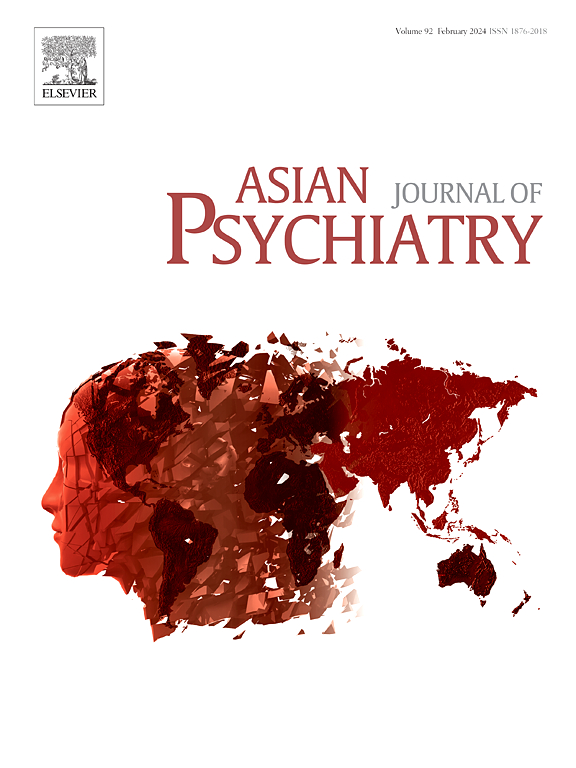机构儿童过去和现在的社会情绪行为困难中暴露于不良童年经历的患病率
IF 4.5
4区 医学
Q1 PSYCHIATRY
引用次数: 0
摘要
不良童年经历(ace)如虐待、忽视和家庭破裂在孤儿中很常见,并影响他们的社会情感发展。了解这些经验对于制定有效的干预措施至关重要。目的评估印度普杜切里儿童护理机构(CCIs)中5-18岁儿童的严重ace和社会情绪行为困难(SEBD)的患病率,并评估两者之间的关系。方法在2022年4月至2023年10月期间,对印度普杜切里的9个cci进行了一项横断面分析研究,涉及195名儿童。采用多级抽样。通过看护人访谈和儿童记录评估cci入院前的ace。目前的SEBD是从看护人的角度使用经过验证的工具进行测量的。计算95% % CI的比例。使用Spearman相关和对数二项回归来评估相关性。结果195例患儿中,66.6% 为女童。严重ACE暴露(≥4 ACE)发生率为42.1 %(95 % CI: 35.2-49.1),其中情绪忽视(60 %)最为常见。女孩(43.8% %)比男孩(10.7 %)经历更多的身体忽视。SEBD存在于47.2% %(95 % CI: 40.2-54.2),主要存在于传导域(52.3% %)。ace量表得分越高,行为问题越严重(rho = 0.2, p <; 0.01)。SEBD患儿发生≥ 4次ace的风险高出1.82倍(p <; 0.04)。结论本研究明确了逆境和行为问题的性质和负担。加强工作人员早期识别和将儿童与适当支助服务联系起来的能力至关重要。本文章由计算机程序翻译,如有差异,请以英文原文为准。
Prevalence of exposure to Adverse Childhood Experiences in the past and current Socio Emotional Behavioral Difficulties among institutionalised children
Background
Adverse Childhood Experiences (ACEs) such as abuse, neglect, and family disruptions are common among orphaned children and impact their socio-emotional development. Understanding these experiences is essential to tailor effective interventions.
Objective
To estimate the prevalence of significant ACEs and socio-emotional behavioural difficulties (SEBD) among children (5–18 years) in Child Care Institutions (CCIs) in Puducherry, India, and assess the association between them.
Methods
A cross-sectional analytical study was conducted across nine CCIs in Puducherry between April 2022 and October 2023, involving 195 children. Multistage sampling was used. ACEs before admission to CCIs were assessed through caretaker interviews and child records. Current SEBD was measured using validated tools from the caretakers' perspective. Proportions with 95 % CI were calculated. Spearman correlation and log-binomial regression were used to assess associations.
Results
Among 195 children, 66.6 % were girls. Severe ACE exposure (≥4 ACEs) was found in 42.1 % (95 % CI: 35.2–49.1), with emotional neglect (60 %) being most common. Girls experienced more physical neglect (43.8 %) than boys (10.7 %). SEBD was present in 47.2 % (95 % CI: 40.2–54.2), mainly in the conduct domain (52.3 %). Higher scores on ACEs scale significantly correlated with conduct problems (rho = 0.2, p < 0.01). Children with SEBD had 1.82 times higher risk of having experienced ≥ 4 ACEs (p < 0.04).
Conclusion
The study identified the nature and burden of adversities and behavioural issues. Strengthening staff capacity for early identification and linking children to appropriate support services is essential.
求助全文
通过发布文献求助,成功后即可免费获取论文全文。
去求助
来源期刊

Asian journal of psychiatry
Medicine-Psychiatry and Mental Health
CiteScore
12.70
自引率
5.30%
发文量
297
审稿时长
35 days
期刊介绍:
The Asian Journal of Psychiatry serves as a comprehensive resource for psychiatrists, mental health clinicians, neurologists, physicians, mental health students, and policymakers. Its goal is to facilitate the exchange of research findings and clinical practices between Asia and the global community. The journal focuses on psychiatric research relevant to Asia, covering preclinical, clinical, service system, and policy development topics. It also highlights the socio-cultural diversity of the region in relation to mental health.
 求助内容:
求助内容: 应助结果提醒方式:
应助结果提醒方式:


